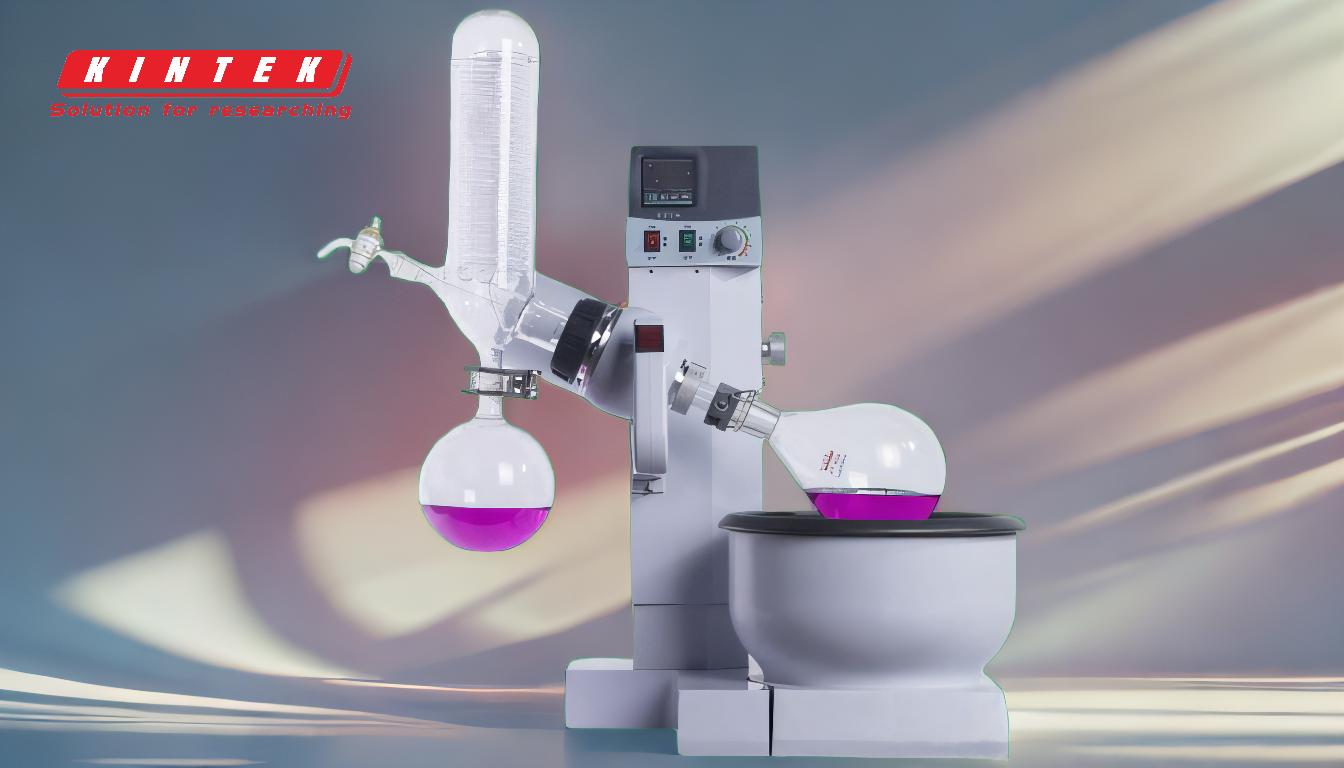Rotary evaporation and simple distillation are both techniques used to separate compounds based on their boiling points, but they differ significantly in their mechanisms, applications, and outcomes. Rotary evaporation is designed for gentle separation, often used in food, pharmaceutical, and chemical industries, where preserving the integrity of heat-sensitive compounds is crucial. It achieves this by operating under reduced pressure (vacuum), lowering the boiling point of solvents, and using a rotating flask to increase surface area for faster and more even evaporation. In contrast, simple distillation is a more traditional method, typically used for separating liquids with distinct boiling points, such as purifying water or concentrating alcohol. It operates at atmospheric pressure and retains the distillate (condensed vapor) as the desired product, while rotary evaporation retains the residue (concentrated compound) in the flask after solvent removal.
Key Points Explained:

-
Operating Principle:
-
Rotary Evaporation:
- Operates under reduced pressure (vacuum), which lowers the boiling point of the solvent, enabling evaporation at lower temperatures.
- The rotating flask increases the surface area of the liquid, promoting faster and more uniform evaporation.
- Designed to preserve heat-sensitive compounds by avoiding high temperatures.
-
Simple Distillation:
- Operates at atmospheric pressure, requiring higher temperatures to achieve boiling.
- Relies on the difference in boiling points of the components to separate them.
- Typically used for liquids with distinct boiling points, such as water and ethanol.
-
Rotary Evaporation:
-
Components and Setup:
-
Rotary Evaporation:
- Includes a rotating flask, vacuum pump, condenser, and collection flask.
- The rotation of the flask ensures even distribution of heat and prevents bumping.
- The vacuum system reduces pressure, allowing solvents to evaporate at lower temperatures.
-
Simple Distillation:
- Consists of a distillation flask, condenser, and collection flask.
- Heat is applied directly to the distillation flask to vaporize the liquid.
- The vapor is condensed back into liquid form in the condenser and collected in the collection flask.
-
Rotary Evaporation:
-
Applications:
-
Rotary Evaporation:
- Ideal for separating solvents from heat-sensitive compounds, such as in the extraction of flavors, fragrances, or pharmaceuticals.
- Commonly used in food science, chemistry, and biotechnology to concentrate samples without degrading them.
-
Simple Distillation:
- Primarily used for purifying liquids, such as water or alcohol, where the goal is to separate and collect the distillate.
- Suitable for applications where high temperatures are acceptable, and the focus is on obtaining a pure solvent.
-
Rotary Evaporation:
-
Outcome of the Process:
-
Rotary Evaporation:
- Retains the residue (concentrated compound) in the original flask after the solvent is removed.
- The solvent is collected separately, often for reuse or disposal.
-
Simple Distillation:
- Retains the distillate (condensed vapor) as the desired product.
- The residue (less volatile components) may remain in the distillation flask or be discarded.
-
Rotary Evaporation:
-
Advantages and Limitations:
-
Rotary Evaporation:
- Advantages:
- Gentle on heat-sensitive compounds.
- Faster evaporation due to increased surface area and reduced pressure.
- Suitable for small-scale laboratory applications.
- Limitations:
- Requires specialized equipment (vacuum pump, rotating flask).
- Limited to solvents with relatively low boiling points.
- Advantages:
-
Simple Distillation:
- Advantages:
- Simple and cost-effective setup.
- Effective for separating liquids with large differences in boiling points.
- Limitations:
- Not suitable for heat-sensitive compounds.
- Less efficient for separating closely boiling liquids.
- Advantages:
-
Rotary Evaporation:
-
Temperature Control:
-
Rotary Evaporation:
- Operates at lower temperatures due to the vacuum, reducing the risk of thermal degradation.
- Temperature control is critical to avoid overheating sensitive compounds.
-
Simple Distillation:
- Operates at higher temperatures, which can degrade heat-sensitive materials.
- Temperature control is less critical unless dealing with closely boiling liquids.
-
Rotary Evaporation:
-
Scalability:
-
Rotary Evaporation:
- Typically used for small to medium-scale laboratory applications.
- Not easily scalable for industrial processes without significant modifications.
-
Simple Distillation:
- Easily scalable for both laboratory and industrial applications.
- Widely used in large-scale production, such as in the alcohol and petrochemical industries.
-
Rotary Evaporation:
By understanding these key differences, users can choose the appropriate method based on their specific needs, whether it’s preserving delicate compounds or achieving high-purity distillates.
Summary Table:
| Aspect | Rotary Evaporation | Simple Distillation |
|---|---|---|
| Operating Principle | Operates under vacuum, lowers boiling point, preserves heat-sensitive compounds. | Operates at atmospheric pressure, separates liquids with distinct boiling points. |
| Components | Rotating flask, vacuum pump, condenser, collection flask. | Distillation flask, condenser, collection flask. |
| Applications | Ideal for heat-sensitive compounds (e.g., food, pharmaceuticals). | Used for purifying liquids (e.g., water, alcohol). |
| Outcome | Retains residue (concentrated compound) after solvent removal. | Retains distillate (condensed vapor) as the desired product. |
| Advantages | Gentle, faster evaporation, suitable for small-scale labs. | Simple, cost-effective, effective for large boiling point differences. |
| Limitations | Requires specialized equipment, limited to low boiling point solvents. | Not suitable for heat-sensitive compounds, less efficient for close boiling liquids. |
| Temperature Control | Operates at lower temperatures, critical for sensitive compounds. | Operates at higher temperatures, less critical for close boiling liquids. |
| Scalability | Small to medium-scale lab applications, not easily scalable for industrial use. | Easily scalable for lab and industrial applications. |
Need help choosing the right separation method for your lab? Contact our experts today!









